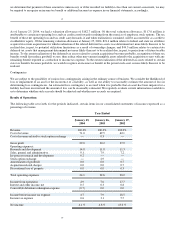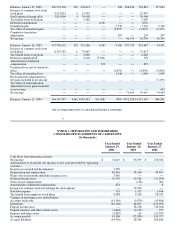NVIDIA 2004 Annual Report Download - page 27
Download and view the complete annual report
Please find page 27 of the 2004 NVIDIA annual report below. You can navigate through the pages in the report by either clicking on the pages listed below, or by using the keyword search tool below to find specific information within the annual report.
We depend on foundries and independent contractors to manufacture our products and these third parties may not be able to
satisfy our manufacturing requirements, which would harm our business.
We do not manufacture the semiconductor wafers used for our products and do not own or operate a wafer fabrication facility. Our
products require wafers manufactured with state−of−the−art fabrication equipment and techniques. We utilize TSMC, IBM and UMC
to produce our semiconductor wafers and utilize independent subcontractors to perform assembly, testing and packaging. Our wafer
requirements represent a significant portion of the total production capacity at TSMC. We depend on these suppliers to allocate to us a
portion of their manufacturing capacity sufficient to meet our needs, to produce products of acceptable quality and at acceptable
manufacturing yields, and to deliver those products to us on a timely basis. These manufacturers may be unable to meet our near−term
or long−term manufacturing requirements. We obtain manufacturing services on a purchase order basis. TSMC has no obligation to
provide us with any specified minimum quantities of product. TSMC, IBM and UMC fabricate wafers for other companies, including
certain of our competitors, and could choose to prioritize capacity for other users or reduce or eliminate deliveries to us on short
notice. Because the lead−time needed to establish a strategic relationship with a new manufacturing partner could be several quarters,
there is no readily available alternative source of supply for any specific product. We believe that long−term market acceptance for
our products will depend on reliable relationships with TSMC, IBM, UMC and any other manufacturers used by us to ensure adequate
product supply to respond to customer demand. Any difficulties like these would harm our business.
28
There can be no assurance that IBM will be able to produce wafers of acceptable quality and with acceptable manufacturing
yield and deliver those wafers to us and our independent assembly and testing subcontractors on a timely basis. .
On March 26, 2003, we announced that we have formed a multi−year strategic alliance under which IBM will manufacture our
next−generation GeForce GPUs. As part of the agreement, we will gain access to IBM’s suite of foundry services and manufacturing
technologies, including power−efficient copper wiring, and a roadmap that is designed to lead to 65nm (nanometer; a billionth of a
meter) in the next several years, giving us valuable tools to advance our GPUs. IBM began manufacturing the next−generation
GeForce graphics processor in July 2003 at IBM’s plant in East Fishkill, New York.
During the development of our relationship with IBM, our manufacturing yields and product performance could suffer due to
difficulties associated with adapting our technology and product design to the proprietary process technology and design rules of IBM.
Any decrease in manufacturing yields could result in an increase in our per unit costs and force us to allocate our available product
supply among our customers. This could potentially harm customer relationships as well as revenue and gross profit. We also face the
risk of product recalls or product returns resulting from design or manufacturing defects that are not discovered during the
manufacturing and testing process. In the event of a significant number of product returns due to a defect or recall, our business could
suffer.
We are dependent on third parties for assembly, testing and packaging of our products.
Our digital media processors are assembled and tested by Siliconware Precision Industries Company Ltd., Amkor Technology,
ChipPAC Incorporated and Advanced Semiconductor Engineering. We do not have long−term agreements with any of these
subcontractors. As a result of our dependence on third−party subcontractors for assembly, testing and packaging of our products, we
do not directly control product delivery schedules or product quality. Any product shortages or quality assurance problems could
increase the costs of manufacture, assembly or testing of our products and could harm our business. Due to the amount of time
typically required to qualify assemblers and testers, we could experience significant delays in the shipment of our products if we are
required to find alternative third parties to assemble or test our products or components. Any delays in delivery of our products could
harm our business.
We rely on third−party vendors to supply us tools for the development of our new products and we may be unable to obtain
the tools necessary to develop these products .
In the design and development of new products and product enhancements, we rely on third−party software development tools. While
we currently are not dependent on any one vendor for the supply of these tools, some or all of these tools may not be readily available
in the future. For example, we have experienced delays in the introduction of products in the past as a result of the inability of then
available software development tools to fully simulate the complex features and functionalities of our products. The design
requirements necessary to meet consumer demands for more features and greater functionality from digital media processors in the
future may exceed the capabilities of the software development tools available to us. If the software development tools we use become
unavailable or fail to produce designs that meet consumer demands, our business could suffer.
Microsoft announced that it had entered into an agreement with one of our competitors to develop technology for future Xbox
products and services. The impact that this announcement may have on our future revenue from the sale of Xbox processors
to Microsoft is uncertain.
On August 14, 2003, Microsoft announced that it had entered into an agreement with one of our competitors to develop technology for
future Xbox products and services. The impact that this announcement may have on our future revenue from the sale of Xbox
processors to Microsoft is uncertain, but we do not anticipate that it will have a significant impact upon us for at least 18 – 24 months.
























